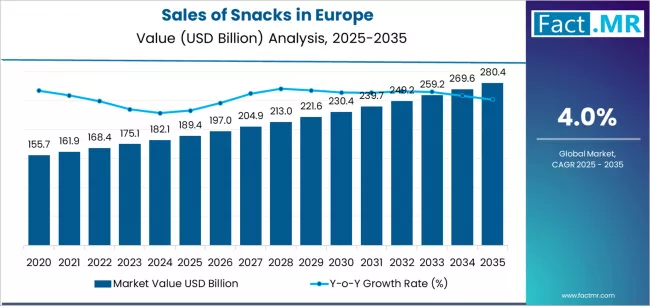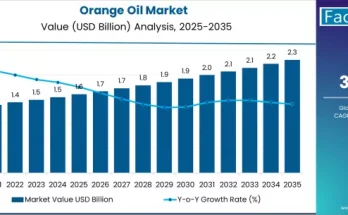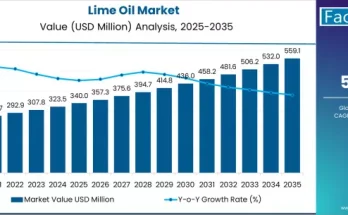The European snacks market is on a robust growth trajectory, fueled by evolving consumer lifestyles, increasing demand for convenient nutrition, and rising innovation in healthier, functional snack products. According to a recent report by Fact.MR, the demand for snacks across Europe is anticipated to grow from USD 189.4 billion in 2025 to approximately USD 280.7 billion by 2035, recording an absolute increase of USD 91.3 billion over the forecast period. This translates into total growth of 48.2%, with demand forecast to expand at a CAGR of 4.0% between 2025 and 2035.
As consumers across Europe embrace mindful eating and prioritize health, wellness, and sustainability, snack manufacturers are redefining the market with high-protein, plant-based, and clean-label innovations that cater to diverse dietary preferences and dynamic consumption habits.
Strategic Market Drivers
- Health-Conscious Consumer Evolution
The modern European consumer increasingly seeks snacks that balance taste with nutrition. Products featuring natural ingredients, reduced sugar, and functional benefits such as high fiber or protein content are witnessing rapid adoption. The ongoing shift toward plant-based and gluten-free alternatives is accelerating market diversification, particularly in Germany, France, and the U.K.
Furthermore, the growing awareness around portion-controlled snacking is driving demand for bite-sized, low-calorie, and fortified snack formats across urban populations.
- Rise of On-the-Go and Premium Snacking Culture
Rapid urbanization, busy lifestyles, and hybrid work models have significantly boosted the consumption of convenient, ready-to-eat snacks. Premium and artisanal snack segments — including gourmet chips, organic nuts, and luxury chocolate assortments — are gaining popularity among younger demographics and high-income consumers seeking indulgence with quality.
Additionally, the integration of local flavors and ethnic-inspired products has enhanced the regional snacking landscape, aligning with the trend toward experiential and sensory-driven food experiences.
- Digitalization and E-commerce Expansion
Online grocery channels and direct-to-consumer (D2C) models are reshaping snack distribution across Europe. E-commerce platforms offer wide assortments, personalized product recommendations, and subscription-based models, supporting consistent sales growth. Strategic collaborations between snack brands and delivery apps are also expanding consumer accessibility and brand reach across emerging European markets.
Browse Full Report: https://www.factmr.com/report/sales-of-snacks-in-europe
Regional Growth Highlights
Western Europe: Innovation Hub for Functional and Premium Snacks
The U.K., Germany, and France dominate regional snack sales, driven by product innovation, high disposable incomes, and strong retail infrastructure. Health-focused snack lines, including protein bars, baked chips, and probiotic yogurts, are increasingly gaining traction. The U.K.’s regulatory push toward reduced sugar and salt content further supports the development of functional snack portfolios.
Southern Europe: Tradition Meets Modern Convenience
Countries like Italy, Spain, and Greece are blending traditional snack formats — such as baked goods, nuts, and cured products — with contemporary health-driven formulations. The Mediterranean diet’s influence is evident in the growing popularity of olive-based and whole-grain snack offerings.
Eastern and Northern Europe: Emerging Growth Engines
Eastern Europe is witnessing strong growth through expanding retail networks and rising middle-class consumption, while Northern Europe continues to lead in sustainability-driven snacking innovations, particularly in plant-based and organic product segments.
Market Segmentation Insights
By Product Type
- Savory Snacks – Potato chips, nuts, seeds, popcorn, and meat snacks dominate overall demand.
- Confectionery & Sweet Snacks – Chocolate and candy-based products maintain strong seasonal demand.
- Bakery Snacks – Croissants, biscuits, and bars gaining traction for breakfast and meal replacement.
- Functional & Nutritional Snacks – Fastest-growing category, driven by protein and wellness trends.
By Distribution Channel
- Supermarkets & Hypermarkets – Continue to account for the largest revenue share.
- Convenience Stores – Preferred for impulse and on-the-go purchases.
- Online Retail & D2C Platforms – Fastest-growing segment through 2035.
Challenges and Market Considerations
Despite strong market prospects, snack producers face several challenges:
- Rising Ingredient Costs: Volatility in commodity prices, including cocoa, nuts, and dairy.
- Sustainability Pressures: Growing regulatory focus on recyclable packaging and carbon reduction.
- Intense Competition: Proliferation of private-label and artisanal brands increasing pricing pressures.
- Health Regulations: Mandatory labeling and sugar-tax policies shaping product innovation.
Competitive Landscape
The European snacks market is highly competitive and innovation-driven. Leading players are investing in plant-based portfolios, reduced-sugar formulations, and sustainable packaging to capture eco-conscious consumers.
Key Companies Profiled:
- PepsiCo Inc.
- Nestlé S.A.
- Mondelez International
- The Kraft Heinz Company
- General Mills Inc.
- Unilever PLC
- Kellogg Company
- Intersnack Group
- Conagra Brands Inc.
- Grupo Bimbo
These companies are expanding their European footprints through acquisitions, product launches, and R&D investments in nutrient-rich, sustainable snack solutions.
Future Outlook: A Shift Toward Smart, Sustainable Snacking
The next decade will redefine Europe’s snacking culture as health, convenience, and sustainability converge. Advances in food science, AI-driven flavor profiling, and sustainable ingredient sourcing will shape innovation. With rising consumer expectations for transparency, personalized nutrition, and eco-friendly packaging, brands that adapt quickly will thrive.
Driven by resilient demand, lifestyle shifts, and green innovation, Europe’s snacks market is poised to remain one of the most dynamic segments in the global food industry — delivering flavorful, functional, and future-ready snacking experiences.



